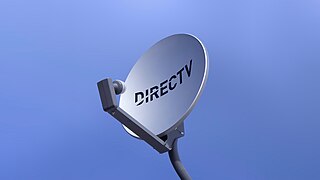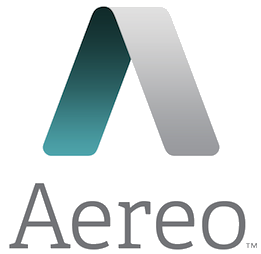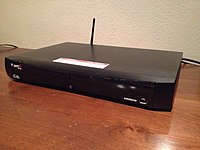
TiVo is a digital video recorder (DVR) developed and marketed by Xperi and introduced in 1999. TiVo provides an on-screen guide of scheduled broadcast programming television programs, whose features include "OnePass" schedules which record every new episode of a series, and "WishList" searches which allow the user to find and record shows that match their interests by title, actor, director, category, or keyword. TiVo also provides a range of features when the TiVo DVR is connected to a home network, including film and TV show downloads, advanced search, online scheduling, and at one time, personal photo viewing and local music playback.
CBS Broadcasting Inc., commonly shortened to CBS, is an American commercial broadcast television and radio network, serving as the flagship property of the CBS Entertainment Group division of Paramount Global.

DISH Network Corporation is an American television provider and the owner of the direct-broadcast satellite provider Dish, commonly known as Dish Network, and the over-the-top IPTV service, Sling TV. Additionally, Dish offers mobile wireless service, Dish Wireless. On July 1, 2020, Dish acquired prepaid service Boost Mobile and added postpaid service Boost Infinite on December 7, 2022. Based in unincorporated Douglas County, Colorado, the company has approximately 16,000 employees.
A digital video recorder (DVR) is an electronic device that records video in a digital format to a disk drive, USB flash drive, SD memory card, SSD or other local or networked mass storage device. The term includes set-top boxes (STB) with direct to disk recording, portable media players and TV gateways with recording capability, and digital camcorders. Personal computers are often connected to video capture devices and used as DVRs; in such cases the application software used to record video is an integral part of the DVR. Many DVRs are classified as consumer electronic devices; such devices may alternatively be referred to as personal video recorders (PVRs), particularly in Canada. Similar small devices with built-in displays and SSD support may be used for professional film or video production, as these recorders often do not have the limitations that built-in recorders in cameras have, offering wider codec support, the removal of recording time limitations and higher bitrates.
Streaming television is the digital distribution of television content, such as television shows and films, as streaming media delivered over the Internet. Streaming television stands in contrast to dedicated terrestrial television delivered by over-the-air aerial systems, cable television, and/or satellite television systems.

Hoak Media Corporation was a broadcast media company based in Dallas, Texas. Hoak once owned eighteen television stations, all in medium and small-markets, mostly in the Great Plains states and Colorado. Hoak Media was established in August 2003.

DirecTV is an American multichannel video programming distributor based in El Segundo, California. Originally launched on June 17, 1994, its primary service is a digital satellite service serving the United States. It also provides traditional linear television service delivered by IP through its U-verse TV brand and a Virtual MVPD service through its DirecTV Stream brand. Its primary competitors are Dish Network, traditional cable television providers, IP-based television services, and other over-the-top video services.

Sling Media Inc. is an American technology company that develops placeshifting and Smart TV solutions for consumers, multiple-system operators and set top box manufacturers. The company is based in Foster City, California, and was a subsidiary of EchoStar Corporation. Their initial product, the Slingbox, debuted on the US market on July 1, 2005. The EchoStar business unit was part of a corporate assets exchange with Dish Network at the beginning of 2017 and now operates as Dish Technologies Corporation under Dish Network.
Multichannel television in the United States has been available since at least 1948. The United States is served by multichannel television through cable television systems, direct-broadcast satellite providers, and various other wireline video providers; among the largest television providers in the U.S. are YouTube TV, DirecTV, Altice USA, Charter Communications, Comcast, Dish Network, Verizon Communications, and Cox Communications. The Telecommunications Act of 1996 defines a multichannel video programming distributor (MVPD) as "a person such as, but not limited to, a cable operator, a multichannel multipoint distribution service, a direct broadcast satellite service, or a television receive-only satellite program distributor, who makes available for purchase, by subscribers or customers, multiple channels of video programming", where a channel is defined as a "signaling path provided by a cable television system."

CNET is an American media website that publishes reviews, news, articles, blogs, podcasts, and videos on technology and consumer electronics globally. CNET originally produced content for radio and television in addition to its website before applying new media distribution methods through its internet television network, CNET Video, and its podcast and blog networks.
Commercial skipping is a feature of some digital video recorders that makes it possible to automatically skip commercials in recorded programs. This feature created controversy, with major television networks and movie studios claiming it violates copyright and should be banned.
FilmOn is an Internet-based television provider owned by FilmOn.TV Networks Inc. Alki David had founded FilmOn.TV Networks in 2006. The company was involved in a prolonged legal case concerning streaming rights with CBS, Fox, and NBC between 2013 and 2017, with FilmOn ultimately settling.

Aereo was a technology company based in New York City that allowed subscribers to view live and time-shifted streams of over-the-air television on Internet-connected devices. The service opened to customers in March 2012, and was backed by Barry Diller's IAC.
A carriage dispute is a disagreement over the right to "carry", that is, retransmit, a broadcaster's signal. Carriage disputes first occurred between broadcasters and cable companies and now include direct broadcast satellite and other multichannel video programming distributors.
Dish Network has been the subject of a number of criticisms relating to management of advertising, disclosure of fees, telemarketing, employee rights and programming disputes; a number of which resulted in lawsuits. In the early 2000s, Dish Network received criticism regarding controversial technology and carriage disputes with programming providers. Most notably, when the Hopper digital video recorder provided an easy way for viewers to watch certain programming without commercials, major networks sued Dish Network.
Fox Broadcasting Co. v. Dish Network, LLC is a copyright case in which the United States District Court for the Central District of California, by granting partial summary judgment, denied most parts of the copyright claims presented by Fox Broadcasting Company (Fox) against Dish Network (Dish) for its service, a DVR-like device that allowed users to record programming that could be accessed later through any Internet-connected device. The service offered by Dish also allowed users to record any or all Fox's prime-time programs and to automatically skips commercials (AutoHop).
American Broadcasting Cos., Inc. v. Aereo, Inc, 573 U.S. 431 (2014), was a United States Supreme Court case. The Court ruled that the service provided by Aereo, which allowed subscribers to view live and time-shifted streams of over-the-air television on Internet-connected devices, violated copyright laws.
PlayStation Vue was an American streaming television service that was owned by the Sony Interactive Entertainment subdivision of the Sony Corporation of America division of Sony. Launched with a limited major-market rollout on March 18, 2015, the service – which was structured in the style of a multichannel video programming distributor – combined live TV, on-demand video, and cloud-based DVR to stream television programs, movies, and sporting events directly to a PlayStation console or other supported device – including smart TVs, digital media players and apps – without a subscription to a cable or satellite television provider. Targeting cord cutters, PlayStation Vue was designed to complement subscription video-on-demand services. As of August 26, 2018, the service had approximately 745,000 subscribers. On October 29, 2019, Sony announced PlayStation Vue would be ending service on January 30, 2020, because "the highly competitive Pay TV industry, with expensive content and network deals, has been slower to change than we expected".

Sling TV is an American streaming television service operated by Sling TV LLC, a wholly-owned subsidiary of Dish Network. Unveiled on January 5, 2015, at the Consumer Electronics Show, the virtual multichannel video programming distributor aims to complement subscription video on demand services for cord cutters, offering a selection of major cable channels and OTT-originated services that can be streamed through smart TVs, digital media players and apps. The service is available in the United States and Puerto Rico as of 2015.

Locast was an American non-profit streaming television service that allowed users to view live streams of over-the-air television stations. The service was founded by attorney David Goodfriend under the banner of the Sports Fans Coalition.










